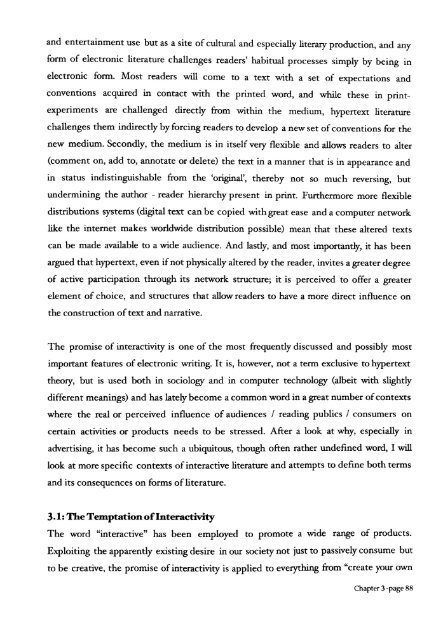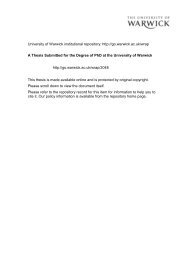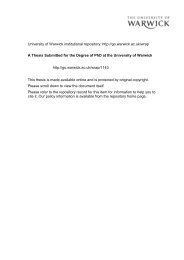From Page to Screen - WRAP: Warwick Research Archive Portal ...
From Page to Screen - WRAP: Warwick Research Archive Portal ...
From Page to Screen - WRAP: Warwick Research Archive Portal ...
Create successful ePaper yourself
Turn your PDF publications into a flip-book with our unique Google optimized e-Paper software.
and entertainment use but as a site of cultural and especially literary production, and any<br />
form of electronic literature challenges readers' habitual processes simply by being in<br />
electronic form. Most readers will come <strong>to</strong> a text with a set of expectations and<br />
conventions acquired in contact with the printed word, and while these in print<br />
experiments are challenged directly from within the medium, hypertext literature<br />
challenges them indirectly by forcing readers <strong>to</strong> develop a new set ofconventions for the<br />
new medium. Secondly, the medium is in itself very flexible and allows readers <strong>to</strong> alter<br />
(comment on, add <strong>to</strong>, annotate or delete) the text in a manner that is in appearance and<br />
in status indistinguishable from the 'original', thereby not so much reversing, but<br />
undermining the author - reader hierarchy present in print. Furthermore more flexible<br />
distributions systems (digital text can be copied withgreat ease and a computer network<br />
like the internet makes worldwide distribution possible) mean that these altered texts<br />
can be made available <strong>to</strong> a wide audience. And lastly, and most importantly, it has been<br />
argued that hypertext, even ifnot physically altered by the reader, invites a greater degree<br />
of active participation through its network structure; it is perceived <strong>to</strong> offer a greater<br />
element of choice, and structures that allow readers <strong>to</strong> have a more direct influence on<br />
the construction oftext and narrative.<br />
The promise of interactivity is one of the most frequently discussed and possibly most<br />
important features of electronic writing. It is, however, not a term exclusive <strong>to</strong> hypertext<br />
theory, but is used both in sociology and in computer technology (albeit with slightly<br />
different meanings) and has lately become a common word in a great number ofcontexts<br />
where the real or perceived influence of audiences / reading publics / consumers on<br />
certain activities or products needs <strong>to</strong> be stressed. After a look at why, especially in<br />
advertising, it has become such a ubiqui<strong>to</strong>us, though often rather undefined word, I will<br />
look at more specific contexts ofinteractive literature and attempts <strong>to</strong> define both terms<br />
and its consequences on forms ofliterature.<br />
3.1: TheTemptationofInteractivity<br />
The word "interactive" has been employed <strong>to</strong> promote a wide range of products.<br />
Exploiting the apparently existing desire in our society not just <strong>to</strong> passively consume but<br />
<strong>to</strong> be creative, the promise ofinteractivity is applied <strong>to</strong> everything from "create your own<br />
Chapter 3 -page 88





